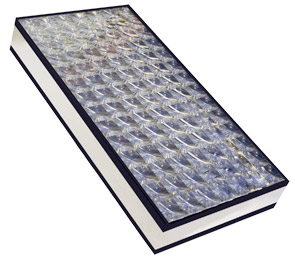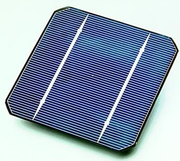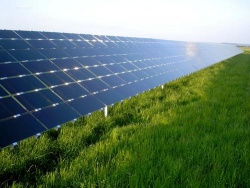Knowledge fuels change
For over a decade, Energypedia has shared free, reliable energy expertise with the world.
We’re now facing a serious funding gap.
Help keep this platform alive — your donation, big or small, truly matters!
Thank you for your support
Solar Cells and Modules
In progress
Solar Cells
A solar cell or photovoltaic cell is a semiconductor device that converts light directly into electricity by the photovoltaic effect. The most common material in solar cell production is purified silicon that can be applied in different ways.
Monocrystalline Silicon PV Cells
Monocrystalline silicon PV cells are made from silicon wafers that are cut from cylindrical single-crystal silicon ingots. The rotund cells have to be cut to form nearly quadratic cells, that can be easily integrated in one module. Thus, refined silicon is wasted in the cell production process. Monocrystalline silicon shows predictable and uniform behaviour, but, due to the careful and slow manufacturing processes required, it is also the most expensive type of silicon.
Modules consisting of monocrystalline silicon PV cells reach commercial efficiencies between 15 and 18 %. So far, they are the most efficient modules and have the largest market share.
Polycrystalline Silicon PV Cells
Polycrystalline or multicrystalline silicon PV cells are made from cast square ingots — large blocks of molten silicon, carefully cooled and solidified. They are less expensive to produce than monocrystalline silicon PV cells, but are marginally less efficient, with module conversion efficiencies between 13 and 16 %.
PVCDROM, an educational website on photovoltaics, shows the production process of polycrystalline silicon PV cells with pictures and viedeo sequences.
Thin Film PV Cells
The various thin film technologies currently being developed reduce the amount (or mass) of light absorbing material required in creating a solar cell. This can lead to reduced processing costs from that of bulk materials (in the case of silicon thin films) but also tends to reduce energy conversion efficiency (an average 6 to 12 % module efficiency),
Thin film PV cells are constructed by depositing extremely thin layers of photovoltaic semi-conductor materials onto a backing material such as glass, stainless steel or plastic. Thin film materials commercially used are amorphous silicon (a-Si), cadmium telluride (CdTe), and copper-indium-(gallium)-diselenide (CI(G)S).
Commercially available thin film modules:
- Are potentially cheaper to manufacture than crystalline cells
- Have a wider customer appeal as design elements due to their homogeneous appearance
- Present disadvantages, such as low-conversion efficiencies and requiring larger areas of PV arrays and more material (cables, support structures) to produce the same amount of electricity
Partly taken from: IEA PVPS
Third generation solar cells
Concentrator photovolatics
Concentrator photovoltaics (CPV) are based on lenses or mirrors which focus direct sun light on solar cells. These cells consist of a small amount of highly efficient, but expensive, PV-material (silicon or III-V compounds, generally gallium arsenide or GaA).
At present concentrating intensities vary from a factor of 2 to 100 suns (low concentration) to 1000 suns (high concentration). Commerical module efficiencies lay in the range of 20 to 25 percent, although efficiencies of 25 to 30 percent could have been achieved with gallium arsenide [1]. An efficiency of 41,1 percent has been achieved in the laboratory by the Fraunhofer Institut für solare Energiesysteme, Germany (concentrating intensity: 450 suns) [2].
In order the course of the sun Concentrator modules are mounted on a 2-axis tracking system. In case of low-concentration-PV there exist 1-axis tracking systens and less complex lenses.

|

|
Organic solar cells
Hybrid dye-sensitised solar cells
instead of semi-conductor material hybrid dye-sensitised solar cells use an organic dye for light absorption. Simple silk-screen allows cost-efficient production costs and offers different scopes for design as implementation in frontages or in advertising purposes [3]. hybrid dye-sensitised solar cells are able to use diffuse sun light. Average efficiencies vary from 2 to 4 percent.
Fully organic solar cells
Organic solar cells are still at an early stage of development. These cells consist of organic hydrocarbon compounds as well as a special electron structure and are able to generate electricity on foils and textiles. At present average cell efficiencies vary between 3 and 5 percent [3]. Minor material consumption and more efficient production technologies lead to a high potential for cost-efficient production. However, there is still need for research activities as life spans are very short.
Cylindrical PV Cells
Solar Modules
For almost all applications, the one-half volt produced by a single cell is inadequate. Therefore, cells are connected together in series to increase the voltage. Several of these series strings of cells may be connected together in parallel to increase the current as well.
Manufacturing process
In order to use the connected cells in practical applications they must be:
- protected from mechanical damage during manufacture, transport and installation and use (in particular against hail impact, wind, sand and snow loads). This is especially important for wafer-based silicon cells which are brittle.
- protected from moisture, which corrodes metal contacts and interconnects, (and for thin-film cells the transparent conductive oxide layer) thus decreasing performance and lifetime.
Therefore, the interconnected cells and their electrical connections are sandwiched between a top layer of glass or clear plastic and a lower level of plastic or plastic and metal. An outer frame is attached to increase mechanical strength, and to provide a way to mount the unit. This package is called a "module" or "panel". Typically, a module is the basic building block of photovoltaic systems
The peak power output of a solar module depends on the number of cells connected and their size. Module performance is generally rated under Standard Test Conditions (STC) : irradiance of 1,000 W/m², solar spectrum of AM 1.5 and module temperature at 25°C. Solar modules are rated in peak watts [Wp] according to their output under STC. Thus, a 50 Wp module can be expected to supply 50 W of power under optimal conditions. The performance is reduced by high temperatures.
Like solar cells modules can be connected in series and/or in parallel to increase the voltage and/or the current depending on the system requirements.
Partly taken from: Polar Power Inc.
Comparison of Different Types of PV Modules
| Cell material | Module efficiency | Surface area needed for 1 kWp | Advantages | Disadvantages |
| Monocrystalline silicon | 15-18 % | 7-9 m² | - most efficient PV modules - easily available on the market - highly standardised |
- most expensive - waste of silicon in the production process |
| Polycrystalline silicon | 13-16 % | 8-9 m² | - less energy and time needed for production than for monocrystalline cells (= lower costs) - easily available on the market - highly standardised |
- slightly less efficient than monocrystalline silicon modules |
| Micromorph tandem (aµ-Si) | 6-9 % | 9-12 m² | . | - more space for the same output needed |
| Thin film: Copper indium diselenide (CIS) |
10-12 % | 9-11 m² | - higher temperatures and shading have lower impact on performance - lower production costs |
- more space for the same output needed |
| Thin film: Cadmium telluride (CdTe) |
9-11 % | 11-13 m² | - higher temperatures and shading have lower impact on performance - highest cost-cutting potential |
- more space for the same output needed |
| Thin film: Amorphus silicon (a-Si) |
6-8 % | 13-20 m² | - higher temperatures and shading have lower impact on performance - less silicon needed for production |
- more space for the same output needed |
Partly taken from: Solarpraxis (Hrsg.): Photovoltaik für Profis. Verkauf, Planung Montage von Solarstromanlagen, 2., vollständig überabeitete Auflage, 2009, S. 131-135.
To compare the price of the different modules, the next database present monthly updated values:http://www.solarserver.de/service-tools/photovoltaik-preisindex.html
Due to their high efficiency, market penetration and standardisation mono- and polycrystalline silicon modules are the most common modules used in solar home systems. However, the market share of thin film modules is growing, especially in free-standing and building integrated PV systems.
For further information on PV modules in solar home systems see the EnDev wiki page on standards for the PV generator.





















